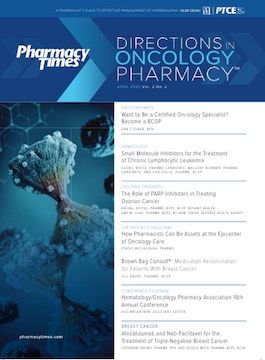Publication
Article
Pharmacy Practice in Focus: Oncology
Brown Bag Consult®: Medication Reconciliation for Patients With Breast Cancer
Author(s):
Oncology pharmacists can prevent errors that occur when a patient’s medications include prescription drugs, OTC medications, herbals, and dietary supplements.
WHETHER THEY WORK in oncology outpatient clinics or in community retail settings, pharmacists have ample opportunities to counsel patients. In the clinic, medication reconciliation is a variation on brown bagging and medication therapy management, both of which can be used to advance communication and prevent errors.
Medication reconciliation is a form of counseling to help ensure that a patient’s medications have been accurately filled and are safe. In performing medication reconciliation, oncology pharmacists can prevent errors that occur when a patient’s medications include prescription drugs, OTC medications, herbals, and dietary supplements. The process allows for a holistic checking of omissions, duplications, dosing errors, adherence, and drug interactions. Furthermore, the services provided by a clinic pharmacist can enhance communication between providers and patients to ensure that careis coordinated. Many oncology patients need support, encouragement, and care coordination. They may endure a grueling process of coping with diagnosis, treatment, and—in cases of recovery—the fear of recurrence. All of these stages affect the patient both emotionally and physically.
RELATED ARTICLE
- Brown Bag Consult®: Case Studies in Medication Reconciliation for Patients Newly Diagnosed With Breast Cancer
As the most accessible member of the health care team, the pharmacist can provide patients with cancer with the information and support they need to get through what might be the most challenging time of their lives. A willingness to help at this crucial time demonstrates a caring and concern that patients likely will never forget.
The goal of a brown bag session is to discover discrepancies. Awareness can help you make a number of short- and long-term suggestions, and your advice may improve communication between KP and her multiple providers. This may help to improve KP’s quality of life and reduce her risk for AEs and hospital admissions.
KP is willing to have you act as a liaison between her and her providers. The first step is to follow up with KP’s providers to make them aware of your brown bag session discoveries and the suggestions you have regarding KP’s plan of care. Time will be your greatest challenge, and you will need to find a way to incorporate these complex clinical opportunities into workflow. However, loyalty and patient satisfaction are priceless, and helping KP is worth the energy.
What thoughts arise after reviewing KP’s brown bag medications? Which laboratory data might have helped when you reviewed them? KP is concerned about palbociclib: about the frequent laboratory monitoring necessary, and about its associated AEs, which she has read about, heard about on TV commercials, and been warned about by a neighbor. KP doesn’t understand why she isn’t getting immuno-oncology drug therapy—which seems newer and “better”—or why some people who receive palbociclib get a shot as well.
How can you explain some of the different breast cancer treatment options? How do you encourage KP to use her oncologist as a resource to explain her treatment plan? KP is definitely someone who needs more coun-seling and follow-up care. You also uncover that KP never received a flu shot. Considering time restrictions, how can you help ensure KP remains adherent now that you have helped her get on track toward a better quality of life?
In this situation, as the pharmacist, you are not a primary decision-maker on the care team. But you can see many nonpharmacological ways you can help JW, as well as recommendations you can make to her oncology care team. As JW’s most accessible resource, you set aside some time to speak with her and explain the different types of breast cancer and the various treatment options for TNBC.
You explain what you know about genetic testing and give JW the name of a counselor at the local hospital who can go into greater detail. JW appreciates your patience in talking things through with her in ways that she can understand. You review JW’s medications and realize she is overusing her prescribed as-needed anxiety and pain drugs.
You offer to follow up with JW’s care team and address the issue of her pain and anxiety, to have them prescribe medication for her that will have longer-lasting effects. In addition, since JW is not eating a balanced diet or getting any exercise, you help her find some recipes specifically designed for patients with cancer who are having issues with taste. You also give her the name of a local dietician who you know.
JW has past documented dyslipidemia and hypertension, yet she admits to not taking any medications for these chronic conditions. A blood-pressure check at the pharmacy shows it is high; you therefore suggest that she follow up with her physician and get back on her prescribed medications, if necessary, after evaluation. In terms of exercise, you mention that you know JW’s support group has a walking club. You tell her that when her pain is more manageable, it will hopefully be easier to move around and perform daily activities, which makes JW crack a smile.
What else can you do for JW? What will your follow-up discussion entail in a month’s time when she needs prescription refills?
For more case studies, visit PharmacyTimes.com.







